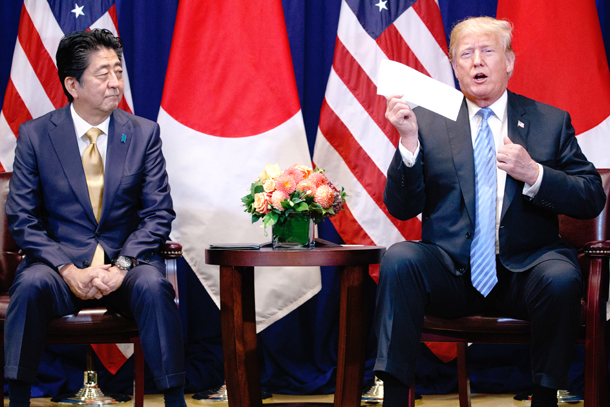Five hard decisions

The author is senior vice president for Asia and Japan chair at the Center for Strategic and International Studies and associate professor at Georgetown University in Washington, DC.
U.S. President Donald Trump greeted South Korean President Moon Jae-in’s September 18 summit with Kim Jong-un with a triumphant tweet telling his followers the outcome was exciting news. In fact, there was little to point to as progress on the core issue of denuclearization. Yes, the momentum is continuing towards a second Trump-Kim summit and the Korean peninsula is in a more stable situation than last year when talk of “fire and fury” seemed unlikely to give way to the de facto freeze on missile and nuclear testing we have had since. Yet Kim continues refusing to even consider putting his nuclear weapons programs or missiles on the table in any comprehensive way.
Instead, Pyongyang has offered to allow inspectors back into the Yongbyon reactor complex (for the third or fourth time since 1992) and to allow monitored dismantlement of the Sohae rocket testing facility. The problem is that the North clearly expects these steps to be the end of the “denuclearization” process, with full U.S. sanctions relief, an end of the nuclear umbrella, and cessation of the U.S. military presence. In multiple forums and media outlets, the North has reiterated that it will be prepared to discuss full denuclearization only when the United States and other “fellow” nuclear weapons states also enter such discussions under the Non-Proliferation Treaty.
In short, Pyongyang is willing to rent the older parts of his program in exchange for de facto nuclear weapons status and no laying of hands on the more dangerous HEU, nuclear weapons or road-mobile HS-15 missiles in the North’s possession. This is not “complete, verifiable, irreversible dismantlement” (CVID) — not even close. Nevertheless, Moon has pushed forward so ambitiously and Trump has been so excited by the pageantry and symbolism of the Moon-Kim summit, that the U.S. administration is now confronted with five hard decisions if it is going to keep the diplomatic momentum alive.

U.S. President Donald Trump shows a letter from North Korean leader Kim Jong-un during a meeting with Japanese Prime Minister Shinzo Abe at the Lotte New York Palace hotel during the United Nations General Assembly, Sept. 26, in New York. [AP/YONHAP]
The Trump administration’s goal was complete denuclearization, not renting the older parts of North Korea’s programs. The first credible step towards actual denuclearization would involve a declaration from the North of all of its nuclear related programs. How otherwise could the administration claim that it is on the path to CVID without a preliminary North Korean list of those facilities and programs to actually be verifiably dismantled?
Such a declaration of facilities was supposed to be one of the major early milestones required of the North in previous agreements such as the Agreed Framework and the Six Party Talks September 2005 joint declaration.
When Trump told Kim that he was prepared to declare an end to the Korean War in June, officials in Washington began looking at ways to make that major concession worth something by demanding in response a North Korean “declaration for declaration.” Kim appears to have never even considered that framework. Instead, he demands a peace declaration in exchange for steps such as the return of the remains of U.S. military personnel missing in action in the Korean War or blowing up the entrance to the Pyungge-Ri nuclear testing facility, which is reversible and gives no accounting of the full North Korean nuclear weapons program. In the rush to achieve a peace declaration, the U.S. negotiators’ leverage to demand a full declaration of North Korean nuclear programs and facilities is diminishing.
The question is whether the more experienced North Korea hands in the administration will have to hold their noses and once again accept North Korean promises regarding Yongbyon when they know that facility is decrepit and a peace declaration could be used as leverage by the North to demand a permanent end to joint military exercises or sanctions needed to keep the pressure on for real denuclearization. This has sparked a debate in Washington. Some, like Victor Cha at CSIS and Abe Denmark at the Wilson Center, are arguing that the Trump administration has no choice but to take hold of a peace declaration in order to shape it and prevent a rupture in U.S.-ROK alliance ties after Moon’s preemptive move to declare peace. Others note that Moon’s proposal is still vague and his public support still mixed and are urging the administration to hold firm.
Two: What to do about joint exercises?
As unpalatable as an Agreed Framework-like Yongbyon deal would be for U.S. officials, the impact of a peace declaration on deterrence and readiness could still be managed if robust U.S.-ROK joint exercises continued. But it is not clear if Trump sees the value of those exercises. In Singapore in June, he called them “war games” — which is the derisive propaganda term used by Pyongyang, Moscow and Beijing. Then, when Secretary of Defense Jim Mattis indicated that there were no plans not to resume exercises, he was shut down in a tweet by Trump.
Putting off or scaling down joint exercises on a temporary basis in order to test diplomacy is one thing, but if the “testing” of diplomacy continues indefinitely and interminably, a temporary freeze can become a permanent one with a negative impact on the readiness of U.S. and ROK forces and the credibility of U.S. alliance commitments. There are rumors growing that Mattis will be out by the new year and questions about whether his successor will have the independence and the grit to push the president to resume exercises given the North’s intransigence on substantive denuclearization.
Three: What to do about Kaesong?
Moon’s inclusion of reopening the Kaesong Industrial Complex in his joint statement with Kim Jong-un puts the administration in a particular quandary. It is well known that the salaries paid to North Korean workers at the complex in the past were de facto cash transfers to the North. Now, those transfers would clearly violate U.S. and U.N. Security Council sanctions against the North. The Blue House may have been holding out the hypothetical possibility of reopening Kaesong to entice North Korea to negotiate in greater earnest, but the language in the Pyongyang Declaration looked more like a surprise fait accompli to many in Washington.
As a matter of international law, the United States could insist that South Korean companies would be sanctioned for reopening operations in Kaesong. However, as a matter of alliance policy, the United States never wants to appear to be an obstacle to inter-Korean reconciliation or reunification. In that sense, Kim Jong-un’s political gambit in his summit with Moon was brilliant. He managed to drive a wedge between denuclearization realists and the U.S. president by appealing to Trump’s predisposition to focus on theater rather than technical details and to drive a wedge between Washington and Seoul by tugging on the progressives’ desire to return to the Sunshine Policy and the majority of Koreans’ hope for reconciliation.
Four: What to do about sanctions?
Secretary of State Mike Pompeo and other senior officials have continued to emphasize to an often skeptical Congress that sanctions will continue on the North even during this period of diplomatic testing. But sanctions require enforcement to be effective and the momentum towards a Trump-Kim summit raises the question of whether new enforcement might spoil the atmosphere for diplomacy. The administration has rolled out a handful of new enforcement measures every few weeks — often targeting Russian or Chinese individuals or entities violating U.S. or U.N. sanctions. Diplomacy without pressure never works, but how much pressure will the administration be able to keep on the North without prompting Kim Jong-un to balk at further talks and potentially inviting the president’s own wrath on those same officials’ heads?
Five: What to do about Trump?
Of course, the one thing that nobody can safely predict — not Moon, not Kim Jong-un, nor Trump’s own national security team — is where Trump himself will be on this issue in a few month’s time. As I wrote in a previous column, Trump administration senior officials are operating on the assumption — and initial presidential guidance — that North Korea must make a strategic decision to abandon its nuclear weapons soon or face a return to maximum pressure, to include more military actions if not actual war itself.
The State Department and the Pentagon are not proceeding with the assumption that these options are off the table. The president himself has not publicly talked about maximum pressure in some time — choosing instead to tweet enthusiastically about his diplomatic accomplishments with North Korea in advance of the U.S. mid-term elections in November.
However, the intelligence community warned this month that the North Koreans continue to build-up their nuclear and missile capabilities as the clock ticks. Senior U.S. administration officials will do their best to keep the president from being too enthusiastic about his next summit with Kim Jong-un, lest he make it more difficult to justify a return to greater pressure if and when the substantive (as opposed to symbolic) denuclearization impasse continues.










with the Korea JoongAng Daily
To write comments, please log in to one of the accounts.
Standards Board Policy (0/250자)